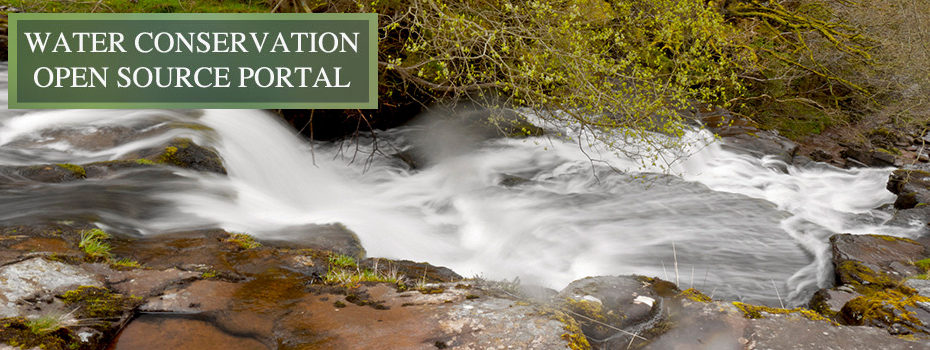Rainwater Harvesting, Water Catchment, and Soil Building Open Source Hub and Portal
Rainwater harvesting methods and water catchment methods are another component of One Community’s open source project-launch blueprinting strategy for building a global collaboration of self-sufficient and self-sustainable teacher/demonstration communities, villages, and cities for the Highest Good of All. Rainwater catchment and harvesting will be incorporated into all seven different village models, the SEGO Center City Hub, our sustainable food systems, and even our sustainable energy infrastructure. This page will function as the portal and hub for all of our water research, development, and on-going open source project-launch blueprinting of an duplicable rainwater harvesting methods and water catchment techniques.
RELATED PAGES
INFRASTRUCTURE OVERVIEW ● SOLUTION BASED THINKING ● OPEN SOURCE PURPOSE
WATER HARVESTING OPEN SOURCE PORTAL
As we continue open source project-launch blueprinting our water harvesting and catchment systems, build them, and problem solve and evolve them for One Community (and with others around the world) we will develop this page as the portal detailing open source and free-shared specifics related to this component including:
● Architectural and design plans for water catchment and storage for each structure
● Detailed materials and providers list for all water catchment components
● Detailed equipment and tools needs list for all water catchment and storage systems
● Cost analysis and build-time analysis for the water catchment system of each component
● How to build each water catchment and storage system and what to watch out for
● On-going maintenance and upkeep details per our on-going experience with each system
● How to make your build easier than ours and how to solve any problems we encountered in our build
● Archive and database of others building similar systems including their experiences, adaptations, etc.
● List of everyone who helped us design and build this so they can be contacted to help others change it
The list above will evolve into links on each individual structure page as well as this open source project-launch hub of all water catchment and rainwater harvesting methods and the details that people need to duplicate every aspect of this component of One Community in part or in whole.
STARTING HARVESTING AND CONSERVATION
One Community is confident that we will be able to create an environment where we are capable of harvesting and storing more water than we use through a combination of water conservation and catchment methods. Here are the initial calculations to demonstrate why we feel we can easily accomplish this.
EARTHBAG DOME CATCHMENT
 The earthbag village (Pod 1) is the first village model we will be building and the water catchment ability of just the domes has been calculated like this: 8′ 10″ radius squared= 11236 inches –> 11,236 X PI (3.14) = 35,281 inches –> conversion to square feet of 35,281 inches = 245 ft squared –> 245 ft squared x 67 pods = 16,415 square feet.
The earthbag village (Pod 1) is the first village model we will be building and the water catchment ability of just the domes has been calculated like this: 8′ 10″ radius squared= 11236 inches –> 11,236 X PI (3.14) = 35,281 inches –> conversion to square feet of 35,281 inches = 245 ft squared –> 245 ft squared x 67 pods = 16,415 square feet.
Applying the formula for calculating water harvesting: 16,415 X (.833) X 7.48 = 102,279 gallons of water harvested per year assuming a (conservative for our location) 10-inch annual rainfall.
CONSERVATIVE WATER USE
Water conservation is equally important to One Community as rainwater harvesting. With this in mind we are starting with a conservation approach to use for the Pioneer Team and the following calculations for each person:
- Shower: 5 gallons (starting to wet, stopping to soap, starting to rinse, finito)
- Brushing teeth: 1 gallons
- Shaving: 1.5 gallons
- Washing dishes .6 gallons (in aggregate as water saving methods used in cleaning in the kitchen as well)
- Toilet: N/A (vermiculture toilets won’t use water)
- Total: 8.2 gallons per day
To make practices like starting and stopping a shower to soap enjoyable, we will be allocating resources to making our bathrooms very warm and comfortable. We are also planning a separate “non-washing” hot waterfall experience (like a hot tub shower) for the ultimate experience of just standing a huge volume of hot water and letting it run as long as a person likes without wasting any water.
INITIAL CATCHMENT TO SUPPLY NEEDS
Combining the calculations above we calculate 8.2 galons of use per person X 365 day in the year = 2,993 gallons of water used per person each year. 102,279 gallons harvested/2,993 gallons per person equals enough water for 34 people just by building water harvesting into the domes themselves. Adding the water catchment from the patio areas and driveways (not counting the SEGO Center City Hub, our sustainable food systems, and our solar panel array catchment) should easily provide enough water for all of the residents of the first earthbag village.
LARGE-SCALE WATER HARVESTING AND CONSERVATION
Over a longer period of time we intend open source project-launch blueprinting and demonstration of large-scale water harvesting and conservation methods also. Here’s a video showing what is possible:
HOW SWAILS CONTRIBUTE TO WATER CONSERVATION
http://www.youtube.com/watch?v=UFeylOa_S4c
————————————–
Why retain water?
- Erosion control
- It builds soil by retaining topsoil which would otherwise flow downstream, ultimately ending up in the ocean.
- Slows the flow of water downstream which reduces flood risk
- Water for agricultural use & drinking
- Healthy soil and fresh water are the foundations of any land based ecosystem
How does one most effectively retain water on a landscape?
- Swales
- Keyline design
- Lakes & Ponds
- Roof harvesting
| A swale on contour catches large volumes of water and allows it to soak into the land. |
 |
| Water caught by a swale absorbing into the land |
 |
| Forming swales |
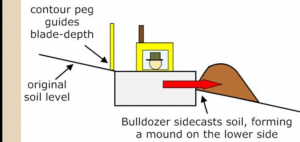 |
| ———————————————— |
| Keyline design |
| Ripping plow lines on contour, pushes rushing water from the valleys out to the ridges |
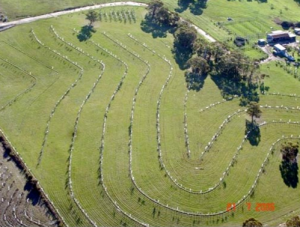 |
———————————————– |
|
Ponds & Lakes |
| Excess water runs off swales into the ponds & lakes |
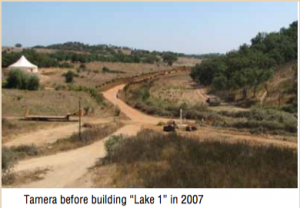 |
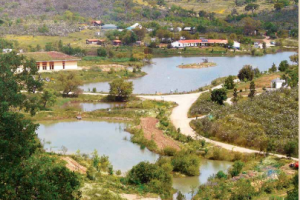 |
| —————————— |
